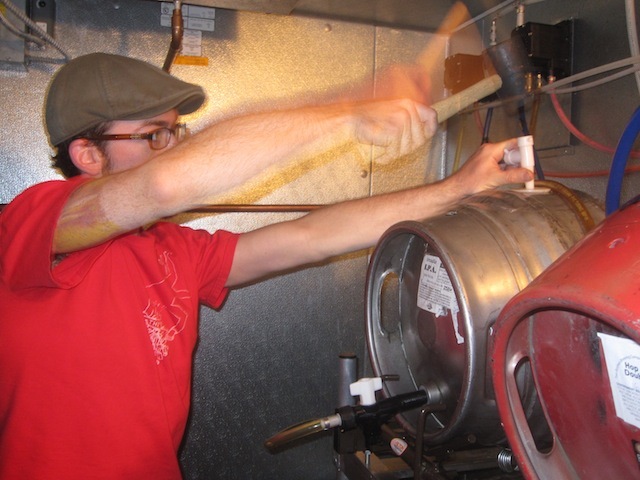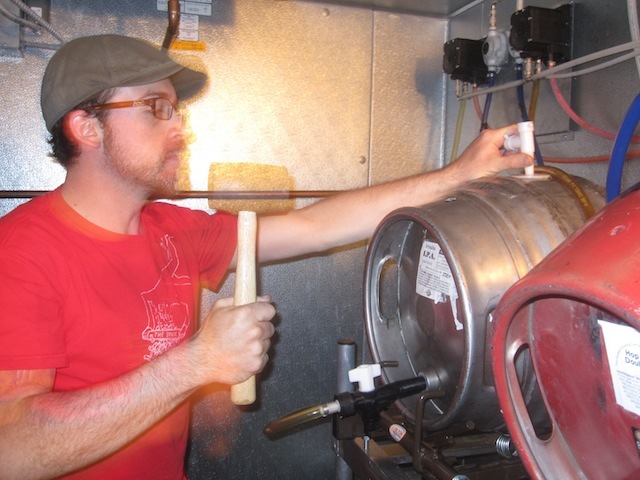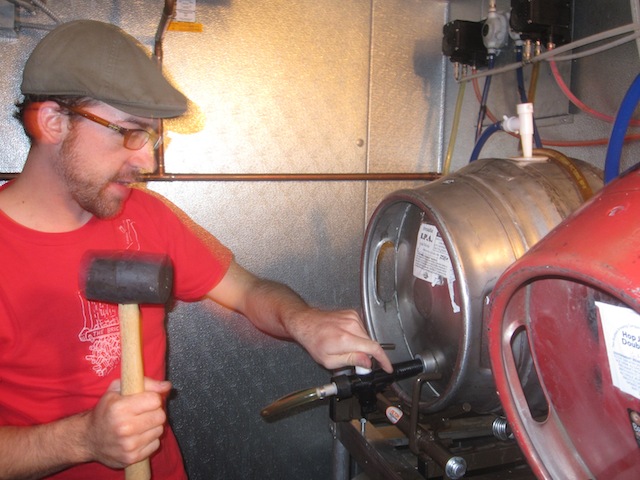One Beer, Warm, Flat, and Cloudy Please.
By Paul Schneider in Food on Mar 1, 2012 7:00PM
Over half of the beer sold in the United States is light beer, and often it's served ice cold and bubbling over with frothy carbonation. In a sense, this is for the best. Let's be real, the more desensitized your taste buds are as they're being soaked in Coors Light, the better. Actually, why don't you take a moment now - you and your tastebuds - to thank the scientists, product designers, and marketers who came up with the cold activation packaging that lets you know your swill is cold enough to guzzle down without offending your palate.
Yet this Saturday, beer geeks will descend upon Goose Island's Wrigleyville brewpub in two waves to taste beers that your average beer drinker would consider warm and flat. The occasion is the Day of the Living Ales, a longstanding annual celebration of cask-conditioned real ale put on by the Chicago Beer Society. Real ale is defined as "beer brewed from traditional ingredients, matured by secondary fermentation in the container from which it is dispensed, and served without the use of extraneous carbon dioxide." It is a traditional British method of serving beer that has become quite rare as less labor-intensive methods have been introduced, like the modern pressurized keg. The growing scarcity and specter of extinction of real ale prompted the 1973 organization of the Campaign for Real Ale (CAMRA), an advocacy group based in Britain that supplies the definition of real ale and organizes its defense.
Here's how it works: beer is packaged into a cask--now usually steel, though wood used to be common--along with a dose of live yeast and a sugary solution. The yeast eats the sugar and produces a delicate carbonation, less than half of what you would find in other commercial beers. The beer is kept between 52 and 57 degrees during service and can be poured simply using gravity, or by use of a handpump.
55 degrees and half the usual carbonation? Yeast in the beer? Why would anyone want to drink this way? Why is this worth defending? "Because it's rare, and when done properly," explains Pete Crowley, owner of Haymarket Pub & Brewery and president of the Illinois Craft Brewers Guild, "it's a great way to drink a beer. A good cask done properly brings the aromas and the flavors of a beer out more. Cold and carbonation mask beer flavors and aromas." Likewise, a properly handled cask will pour beer that is clear and bright, as the cellarman will have treated the beer with finings and given it the time and care for the yeast to flocculate, or drop out, to the bottom of the cask.
Elliott Beier is a Certified Cicerone - the beer world's version of a sommelier - and directs the beverage program at the British-inspired Logan Square gastropub Owen & Engine, where four hand pumps dispense the most consistent and ambitious cask program in the city. Beier explains that beer has been served on draft since the fifth century and that, until the 1950s, almost all beer in Britain was served in wooden casks. "Many people think that cask-conditioned beer is the best, truest way to serve beer to really smell, taste, and appreciate what it has to offer," he said. "Thanks to the difference in temperature, you taste far more of the malt complexity, and more of the hops too. You get less bitterness, but the flavors hops impart are way more subtle, with flowery, spicy, and earthy characteristics that you don't usually taste."
Not all the virtues of real ale come from the temperature. Most beer is pasteurized during packaging, killing any yeast still in the beer, and some of the more delicate flavor and aroma compounds along with it. But not real ale. "It still has living yeast in in it, which will continue to change the beer as it's tapped," Beier went on. "It will taste completely different on day one and day three."
One of Beier's favorite beer geek-outs is to taste the same beer on cask and draft, side by side. "It's like night and day," he claims. "There's so much more complexity in a cask beer it's incredible. Cask ale is meant to show a beer for what it should really be, exactly what malt you're tasting, exactly what hops you're tasting and the symphony of all that complexity."
Conditioning ale in a cask also gives brewers another opportunity for experimentation. Beier has served Two Brothers casks with extra dry hops, a Metropolitan copper lager with black pepper, and Greenbush's copper wheat ale with Earl Grey tea.
So if cask is the best way to really experience beer, why don't more bars and restaurants serve it? "Cask beer is a living breathing thing," said Crowley. "It's a delicate balance, takes extra steps to cellar and care for, and doesn't stay 'perfect' as long as draft beer. You can't just 'tap and go' so the bar must take extra time to do it right."
Steve Hamburg, cellarmaster for the Day of the Living Ales and co-founder of the event that spawned it, believes the biggest problem for cask ale is that "too few people understand cellarmanship, the set of unique skills needed to handle each cask of beer to optimize the clarity and maintain a suitable level of carbonation. Temperature control is also an issue. While some bars have separate coolers for their cask beers with temperature set closer to 50F than 35-38F in most coolers, [the average range for draft beers,] others do not. "
That's where Day of the Living Ales comes in. Every year, 500 beer geeks gather to celebrate real ale's virtues in defiance of all the obstacles to its acceptance and popularity. The myths of warm, flat, cloudy beer be damned. To hell with the lack of expertise and the outsize care and expense. This Saturday is all about real ale, properly done.
Unfortunately for most of us, we won't be a part of it. As you might expect if you've been keeping tabs on the beer hysteria surrounding special releases and festival ticket sales, this year, Day of the Living Ales sold out in record time. "There are no plans to expand the festival, mainly because of the difficulty in obtaining a suitable venue," explained Hamburg. "It's not simply the size of the venue that's a problem, it's that cask ale requires care over many days if it is to be presented properly. We have yet to find a place willing to yield their facility for the required amount of days, or, if they will, at a price that makes it financially viable."
As Chicago's craft beer scene heats up, demand for scarce beers and beer experiences like Day of the Living Ale will continue to frustrate consumer expectations until the supply starts to catch up.
Looking for real ale in the meantime? Find a bottle-conditioned ale at your favorite bottle shop. This designation indicates there is live yeast in the bottle, and fits the CAMRA definition. A bottle-conditioned beer is likely to be more carbonated than its cask counterpart, so pour hard, and serve at 55 degrees. Otherwise, Owen & Engine, Map Room, Fountainhead, SmallBar, Goose Island - Clybourn, and Bavarian Lodge consistently serve quality cask-conditioned beer.
Read more about real ale at All About Beer.



